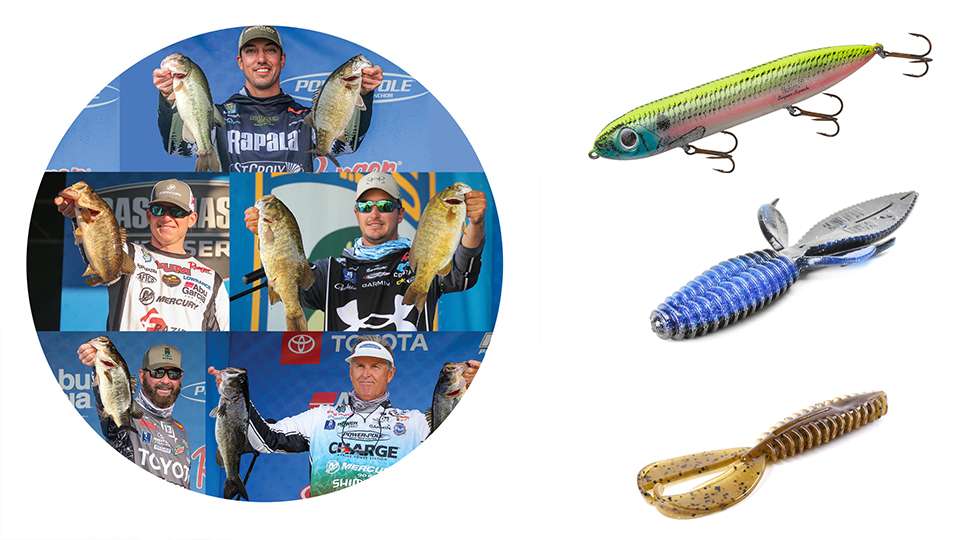
The summer-fall transition can be a disjointed time when hunting whopper fish often becomes a frustrating exercise of hit or miss. Bassmaster Elite Series pros know how to remove the random and leverage well-conceived strategies that maximize consistency.
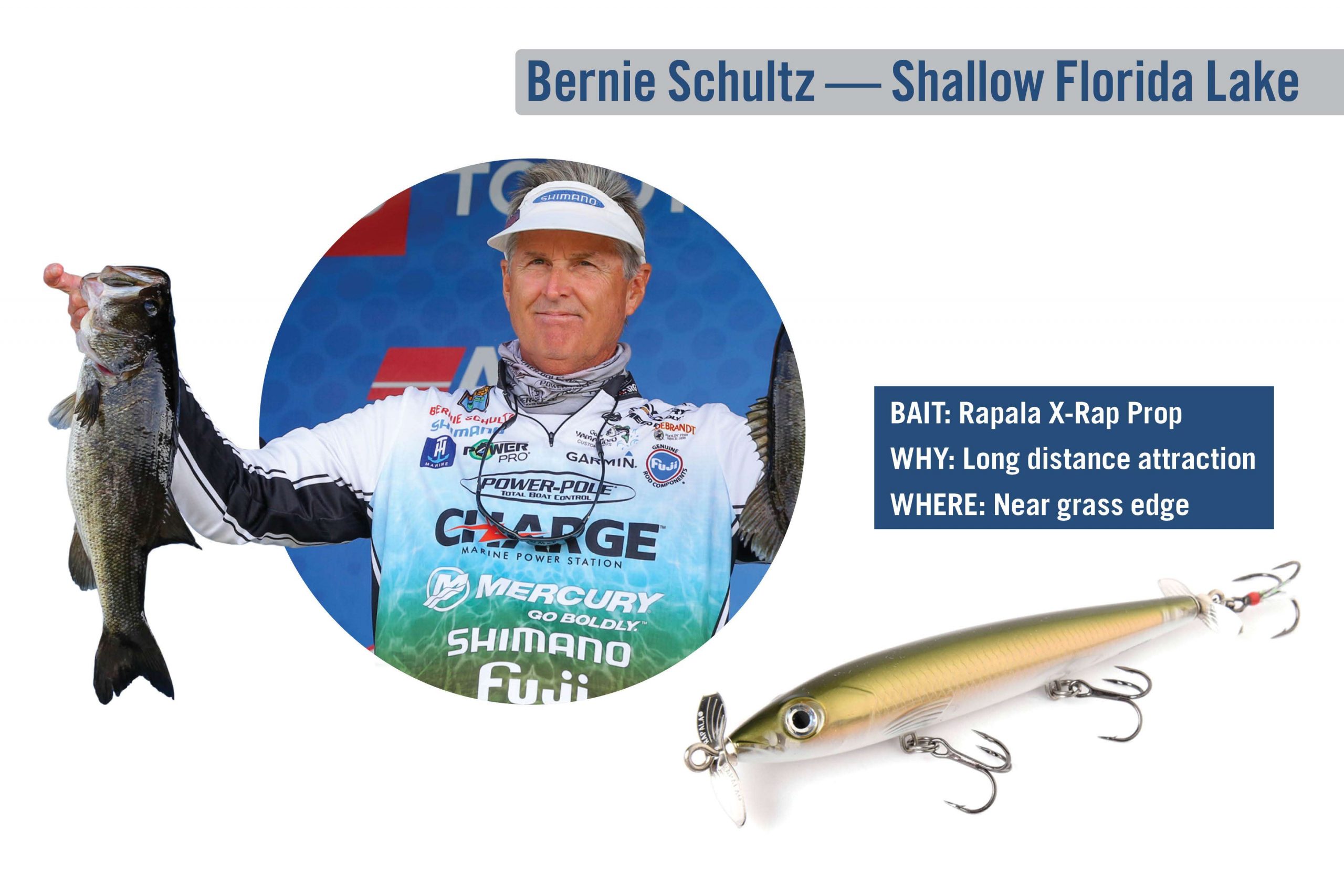
Bernie Schultz — shallow Florida lake
For tempting the Sunshine State monsters, Schultz chooses a prop bait like the Rapala X-Rap Prop or a Smithwick Devil’s Horse. Preferring reflective finishes — chrome or gold — he finds these sputtering baits appeal to the big ones’ seasonal proclivity.
“Water temperatures are cooling, fish are starting to look up, there could be schooling activity going on, and big fish will be attracted to that,” Schultz said. “They may not be participating in the schooling, but they could be around it; taking advantage of it.
“It’s also a good way to attract a fish from thicker cover, grass in particular, but also cypress trees, treelines along riverbanks. A topwater prop bait can call fish a distance and provoke bigger fish to strike.”
Speaking to his big-fish presentations, Schultz said slower is better — as slow as you can stand. Give it a couple of short pulls and let it sit long enough to check your text messages. Vicious strikes typically occur when the bait comes to rest or the moment motion resumes.
“Florida-strain largemouth are picky eaters,” Schultz notes. “They’ll study bait for a long time before they decide to attack it, so patience is key — particularly with bigger fish. It seems like the bigger the fish, the more educated they are and the more reluctant they are to take an artificial bait. The angler with the most patience is going to score most often.”
Schultz throws his prop baits on a 7-foot medium Shimano Expride rod with a 6:1 Shimano Metanium MGL reel carrying 15- to 20-pound monofilament line. A buoyant line keeps the bait in effective position, while prudent reel choice ensures effective presentation.
“I think a slower gear ratio lends itself to slower retrieves,” Schultz said. “I think the tendency with a higher-ratio reel is to take up too much line and move the bait too often. Less is best when you’re fishing big topwaters for big bass.”
Schultz also stresses reading the water. Big fish will often disclose their presence when a lure’s at rest by dimpling the surface. Detecting such signs helps you determine what triggers a strike — such as longer pauses and sudden twitches — and replicable patterns often arise.
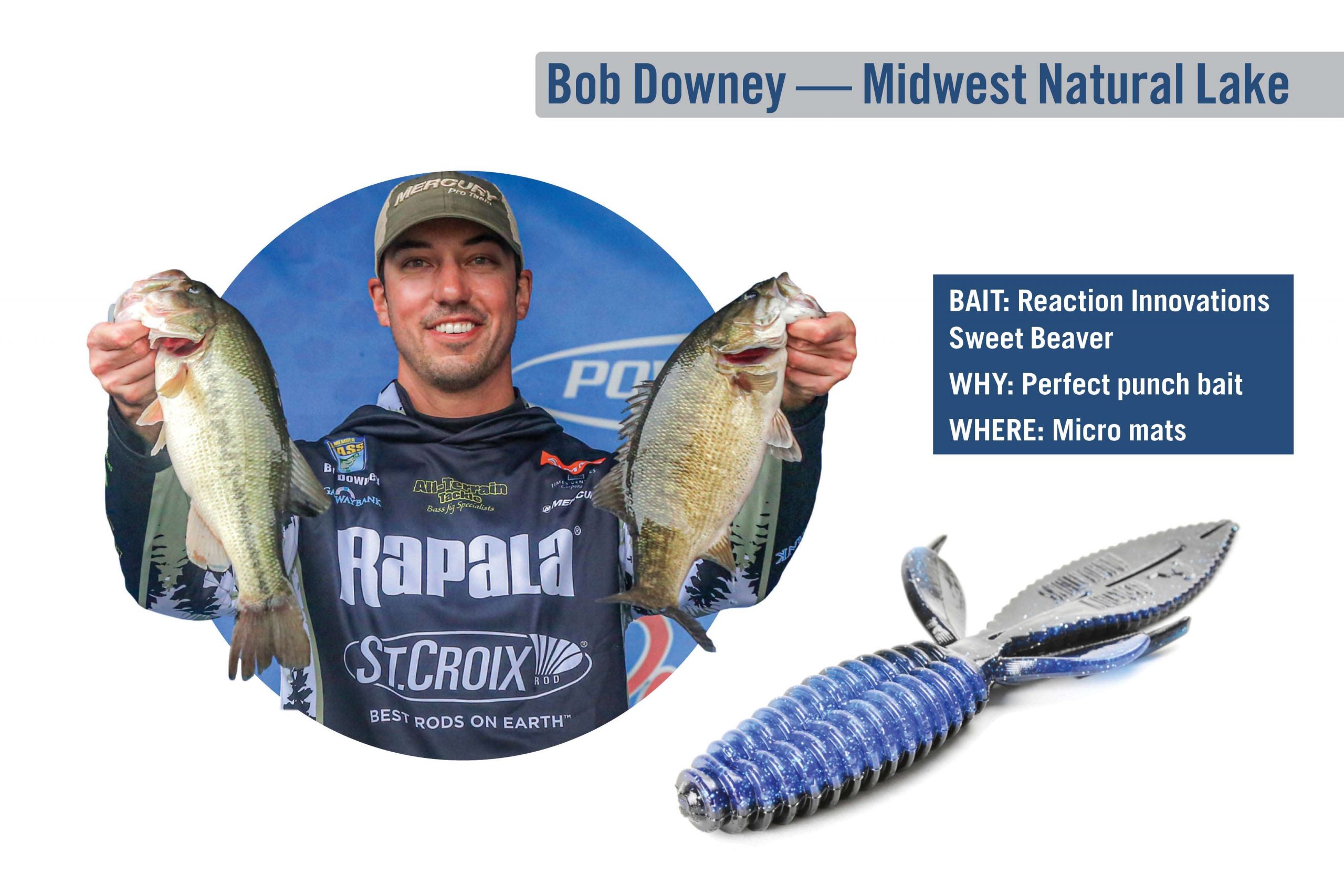
Bob Downey — Midwest natural lake
With a lot of the region’s fish returning shallow, Downey expects any remaining topped-out grass to offer big fish a valuable solace. Even more strategic are what he terms “micro mats” — small rafts of dead, floating vegetation that float into lily pads or vertical cover such as bulrush, cattails and pencil reeds.
“The hard stem cover that really doesn’t uproot will stay there and catch all the other grass that’s starting to die off,” he said. “The wind blows it all in there and it creates small mats no bigger than the size of a boat. They’re isolated and very high-percentage spots and, a lot of times, the biggest fish in the lake will get up under that cover.”
Baitfish transitioning to shallow cover will find these mats and help create the ideal cafeteria. Punching is the most efficient method for reaching the big fish that gravitate to this isolation, and Downey does so by driving a Reaction Innovations Sweet Beaver through the canopy with a 3/4- to 1-ounce weight.
If that bite’s not happening, Downey looks for a lake’s last remaining docks. With winter ice on the way, waterfront homeowners pull in their docks by fall, but there are always a few procrastinators who create opportunity for savvy anglers.
“There’s often a few docks still in the water in that September/October period, and I’d want to skip a jig underneath those,” Downey said. “I’d use a 3/8- to 1/2-ounce All-Terrain Tackle [skipping] jig with a Reaction Innovations Smallie Beaver trailer.
“The docks get a lot of pressure this time of year, but if you can find those micro mats, a lot of times, you can have them to yourself. If there are only a handful of those mats, you might catch one of the biggest fish in the lake that has slid up there and hunkered in.”
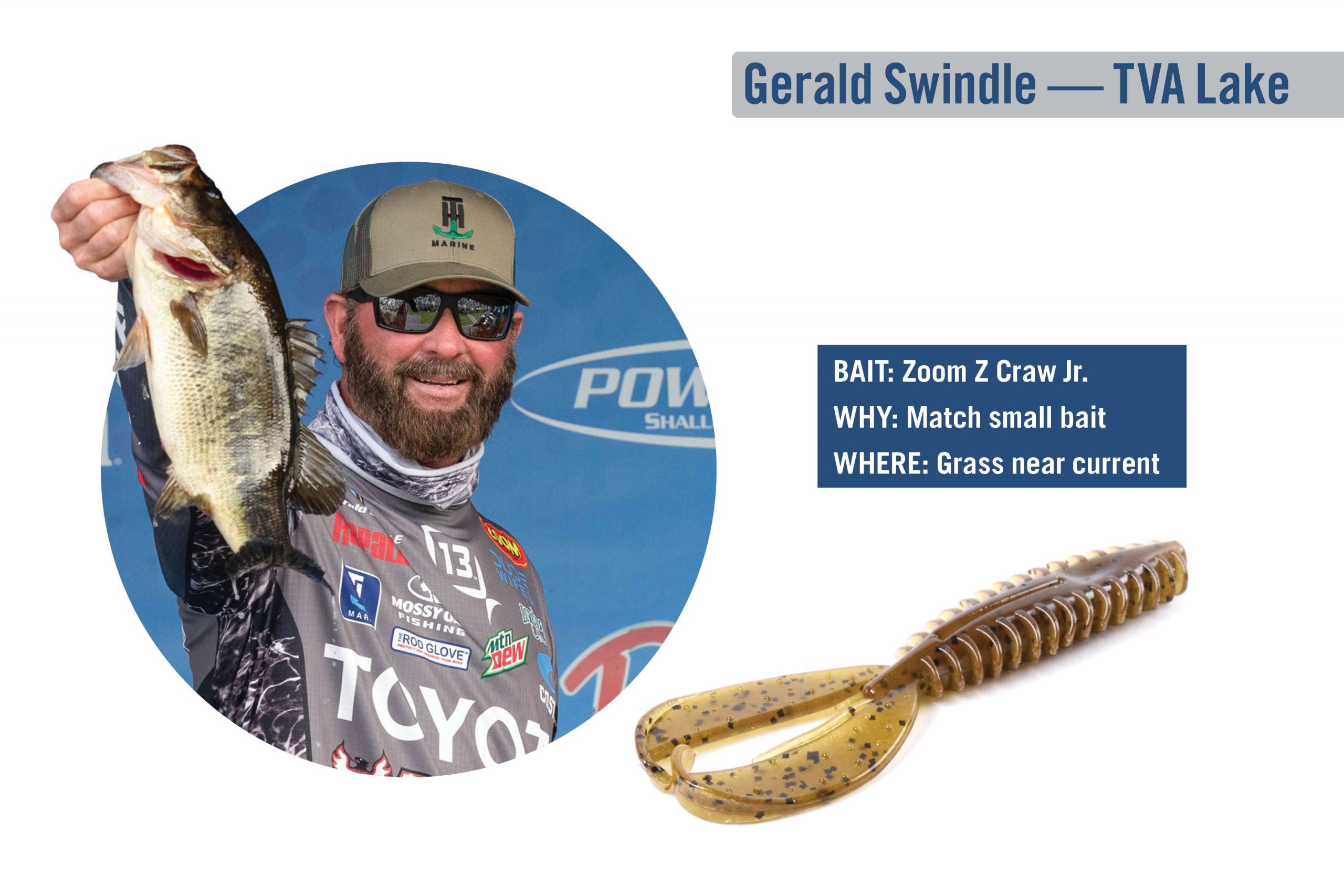
Gerald Swindle — TVA lake
The two-time Bassmaster Angler of the Year knows the offshore game well, but when it’s kicker time on lakes like Pickwick, Wheeler and Chickamauga, the term “one-trick pony” does not apply. In his experience, turning to the seasonal staging areas is the smart play.
“On a TVA lake in September, what a lot of people are going to initially think is, ‘Deep,’ but some of the biggest bites you’re going to catch [this time of year] will probably be flipping deeper grass,” Swindle said. “By September, those fish have already started that transition back in, but they’re not already back in the creeks. They’re right off the river in some of that deepest grass.”
Swindle’s looking for matted hydrilla, milfoil or coontail grass surrounded by 6 to 10 feet of water. Shady canopies are the key element but, as he explains, those fish want to be near the cooler, food-rich water.
“The key that time of year is to look for grass that has current around it,” Swindle said. “That’s where guys will show up in a tournament, and they won’t catch but six fish all day, but they’ll have 23 to 24 pounds.
“The fish will be right off the river channel. You’ll jump up out of 15 feet and the grass starts; the fish won’t be but a foot or two back in that [cover]. So they’re still getting the benefit of the flowing water and the bait, but they’re also getting the benefit of the shade. That’s the first thing they see.”
Having endured a summer of nearly nonstop pressure on the channel ledges, humps and high spots, the big fish leave these traditional summer retreats quicker than most might believe. Locating canopied grass in this transition zone often reveals a gold mine.
Swindle mines this treasure with two flipping setups — one light, one heavy. He’ll rig a Zoom Z Craw Jr. on a 4/0 VMC straight-shank flipping hook with a 3/4- and a 1 1/4-ounce weight. Big bait, big fish? Yeah, that’s not always relevant.
“The reason you want to flip those smaller baits that time of year is a lot of the baitfish that are first coming in are small, and a smaller bait goes down through those mats so much better,” he said. “If you try to flip too big a bait in those mats, it’s not going to penetrate.
“I use two rods and it’s a pretty simple setup — 50-pound Sunline SX1 braid and a 7-6 medium-heavy 13 Fishing rod — and I just go down through there flipping. If the mat’s superthick, I jump up to an ounce and a quarter; if I get into an area with sparser grass, I’ll drop down to that 3/4 ounce.”
Matching bream is key, so Swindle’s big on green pumpkin candy, green pumpkin/blue flake or green pumpkin swirl. Tip: Let the bait fall on a slack line and vary the looks from the bottom to mid-depth to upper water column.
“You see so many people flip it in, let it hit the bottom, hop it twice and pull it out, but I’m the guy that says, ‘Alter your presentations,’” Swindle advises. “Don’t flip it too fast and, if you’re sitting in 10 to 12 feet of water and you see that line drop 8 or 12 feet, don’t be afraid to pull that bait back up to where it’s only a foot under that mat and just hold it still.
“It’s the most awkward presentation; just hold it. If the fish are just under the canopy, they’ll swim over and get it.
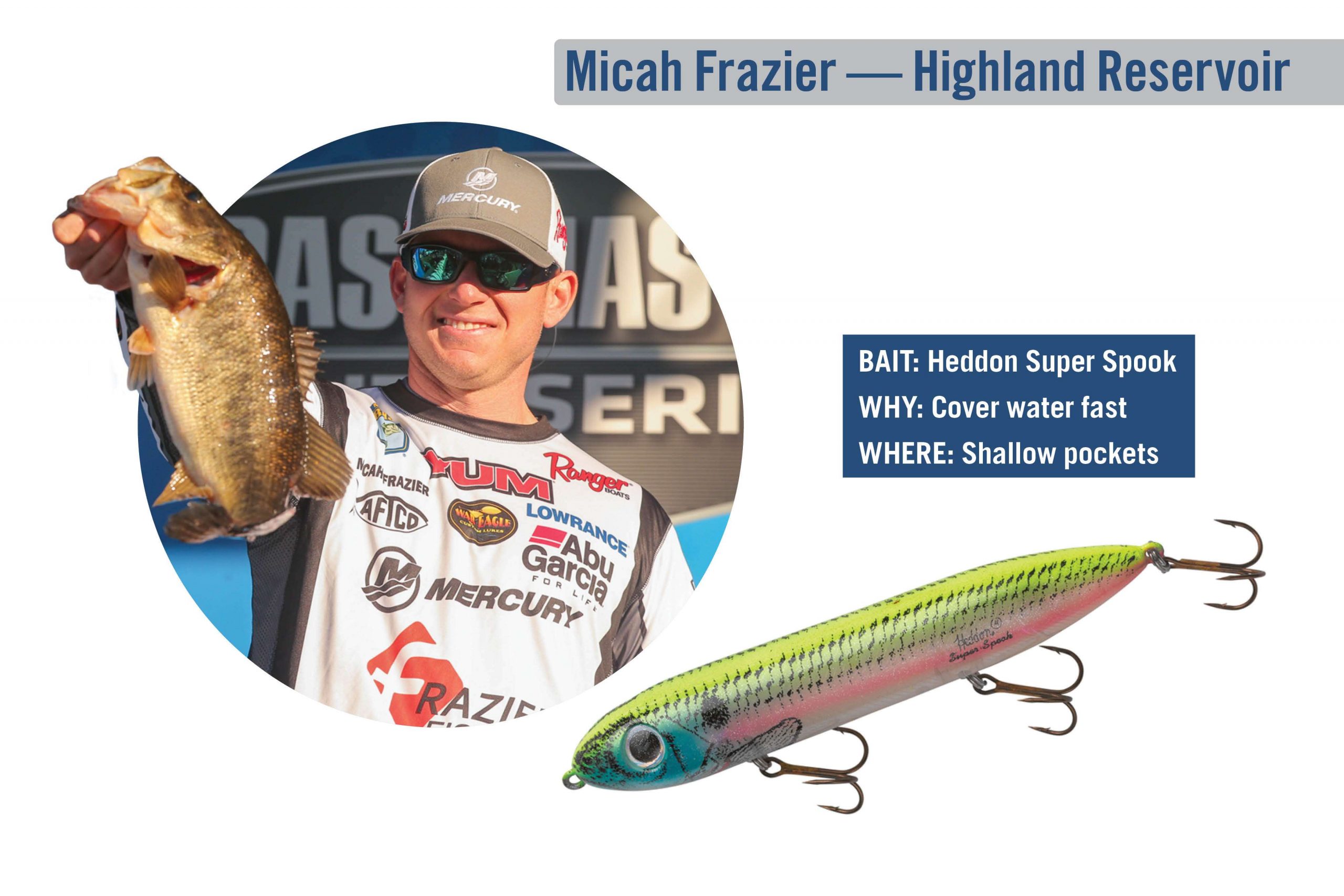
Micah Frazier — highland reservoir
Knowing that a good number of the fish will stay shallow all year, with more starting to transition from summer haunts, Frazier looks for wolf packs. Big fish will roam the shallows in search of bream, even after the panfish have concluded their spawning activity.
“I’ve caught a lot of big fish in the fall doing that,” Frazier said. “The fall on reservoirs is kind of random, and you can catch big fish doing a lot of things, but late summer and into the fall, a lot of big fish leave the deep deal because they don’t like competing with the spotted bass, the stripers and all that stuff, so they go back shallow to feed on bluegill.”
When he’s hunting wolf packers, Frazier wants to be close to laydowns, docks and flooded vegetation in shallow pockets and bays. The bite’s not necessarily limited by time, but Frazier naturally gravitates to the shadier areas during brighter periods and expands outward in the low light of early mornings, late afternoons or overcast conditions.
Frazier’s top choice for wolf pack missions is a Heddon Super Spook in the Okie shad color. Once he’s dialed in the target zone, his formula for success is heavy on enticement but light on progression.
“I cover water pretty fast until I’m in an area that has some fish, and then I slow it down and kind of walk it harder to try and draw those strikes,” Frazier said. “You don’t necessarily walk it faster, but twitch it back and forth and make that thing walk the dog [more forcefully]. You want it to move more erratically without moving back toward the boat faster.”
Keen observation plays a big role here, as spotting fish, pushes or shadows helps narrow the playing field. The fish could be just about anywhere in the shallow zone, but Frazier expects to find clusters of activity.
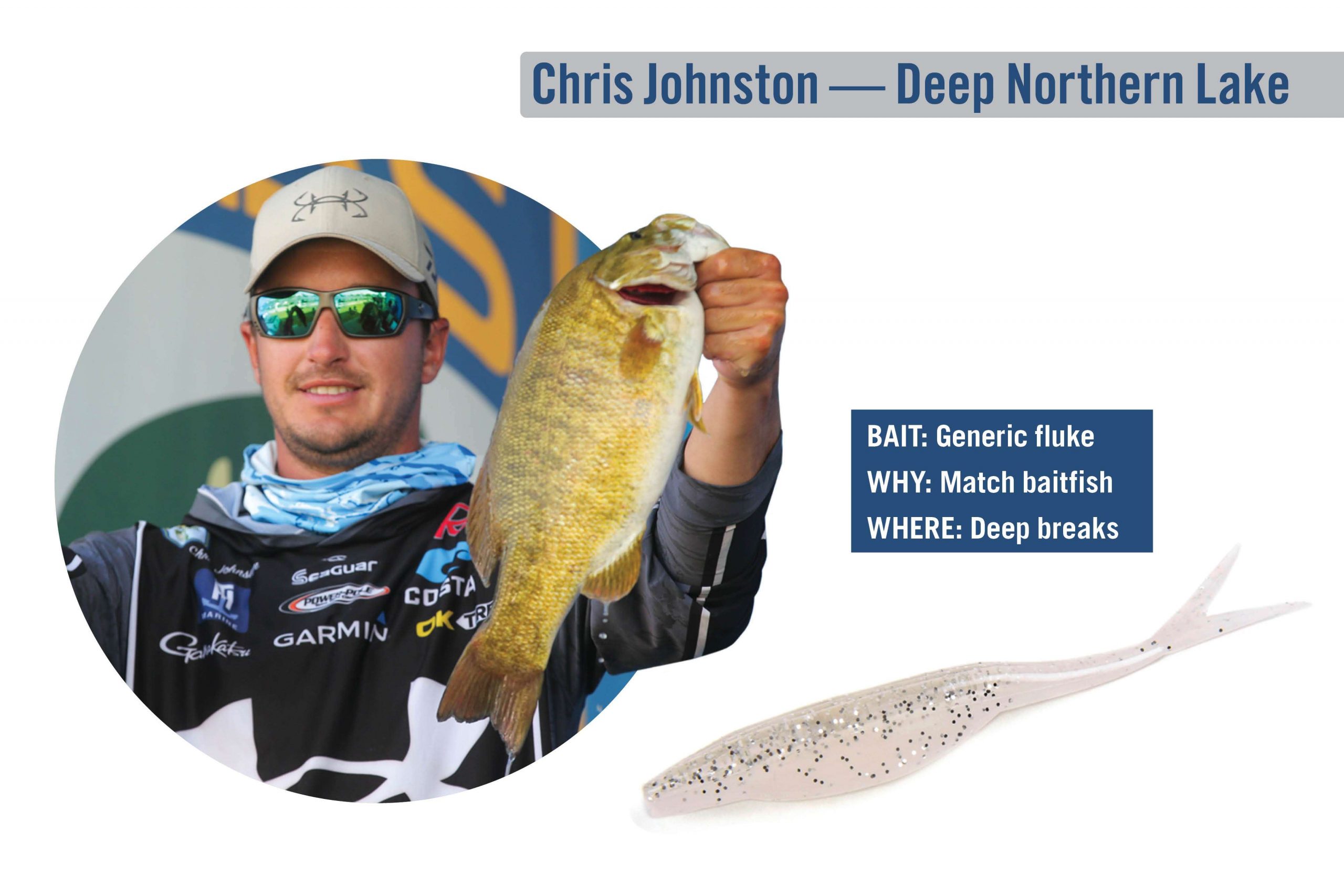
Chris Johnston — deep Northern lake
The thing about Northern smallmouth fisheries is that it’s often fairly easy to find numbers, but locating quality fish requires insight. Further, identifying the straight-up studs demands a higher level of determined effort.
“On the Great Lakes, the fish are deep that time of year, and I find that they group up by size,” Johnston said. “So, if you’re catching 2- to 4-pounders, you’re probably not going to get that 7-pound smallmouth.”
When he’s on the hunt for something big and brown, Johnston’s looking for a sharp break in 30 to 40 feet. Scanning this contour, he knows that spotting a fish every couple hundred yards usually indicates the giants he wants.
“These are single, isolated fish, and you’re using your electronics to find them,” Johnston said. “That’s where I think you’re going to get that true giant smallmouth in the Great Lakes.”
Noting specifics, Johnston said he’ll look for a steeper section on the break or a distinct hard section — something different, he said. Food’s always a motivator, so it might be that there’s bait in a particular section along the break.
“If you’re fishing deeper, it’s hard to beat a drop shot,” Johnston said. “I use a fluke-style bait because a lot of times, they’re keyed in on baitfish. A 4- to 5-inch fluke is good for big fish.
“If they’re being finicky, I’ll make long casts with a swimbait, like the 3.8 Keitech Swing Impact on a 3/8-ounce football-head jig. I creep it just off the bottom.”
Originally appeared in Bassmaster Magazine 2021.





